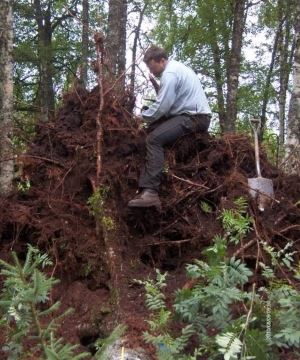
CENBIO - Enabling sustainable and cost-efficient bioenergy in Norway
SP1 - Biomass supply and residue utilization
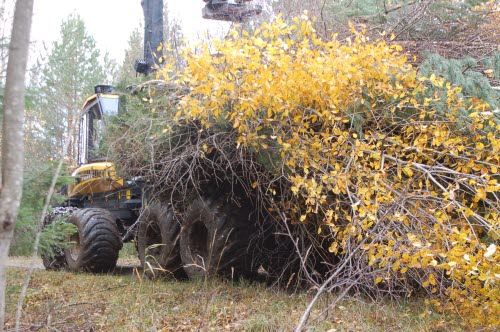
An important activity in SP1 in 2015 been to improve the biomass estimation in Norway. The work has focused on the development of new methods and models that can be used in inventories for assessing forest biomass, including roots, stem and branches. Very little has previously been done on assessing the biomass estimation of roots and branches. This has been the topic for Aaron Smith's dissertation in 2015. The main objective of his work was to improve individual tree biomass estimation both aboveground and belowground. This work has made a significant achievement facilitating accurate estimation of improvement to assess the biomass stock in Norway, both below ground and above ground.
Some of the forest in Norway has harvesting restrictions, and researchers have worked with methods and tools that may support forest managers to minimise economic losses and to handle and avoid conflicts in recreational areas. Issues related to cost-efficient harvesting operations have also been covered. Clustering of harvesting sites is important to reduce the fixed-costs and increase the net present value.
Chipping at forest roadside landing and consecutive woodchip transport is a common step in the supply chain. By studying 13 chipping contractors in Norway, the conclusion from practitioners in the field trials indicates substantial operational delays originating from poor working conditions or work organisation. The time consumption for the chipper varied between 0.7 and 1.6 minutes per m3 loose and the utilization varied between 35% and 70%. Poor terminal functionality was mostly related to limited flat area of sufficient bearing capacity on the terminal.
The chemical compositions and fusion behaviours of ashes from stem wood, bark, base branch and top branch have been characterised. Compared to other three ashes, top branch ash contains considerably high content of K and P, and is rich in Ca and Si as well. Analyses on four fuel types indicated that melting of them might start in the temperatures range of 930-960 °C. In comparison to ash originated from stem wood, analyses confirm that the ashes from stem bark, base branch and top branch have higher sintering tendency. Top branch ash contains substantially high concentration of K and P elements. These two typical mobile elements in plants are often found in twigs containing a large amount of young and biologically active tissues.
Moisture content is one of the most important quality parameters of forest biomass used for bioenergy. The standard method currently used for determining moisture content involves oven drying at 105 °C until stable weight is reached (oven-drying method). For buyers of biomass, a disadvantage of the oven-drying method is that it takes at least 24 hours before the moisture content of the delivered biomass is determined. The accuracy for frozen and non-frozen chips have been tested with the near infrared spectroscopy. The tests were successful and the method was approved by Virkesmätningen (VMK) in Sweden in December 2015.
More information on the research activities can be found in the latest CenBio Annual Report.
WP1.1 - Feedstock Supply
The main activities in 2015 of WP1.1 may be divided into two main parts:
-
The first part focused on the development of new methods and models that can be used in inventories for assessing forest biomass.
-
The second part dealt with bio-economic optimisation methods handling
linkages between silvicultural treatments, economic behaviour, sustainability
criteria and biomass supply in forest decision-support tools.
Methods and models for assessment of forest biomass
Aaron Smith, PhD student at NMBU, but funded by CenBio through Norwegian Institute of Bioeconomy Research (NIBIO), defended successfully his thesis on October 22, 2015. The main objective of the thesis was to improve individual tree biomass estimation in order to improve biomass estimation in Norway. Aaron's advisors were Andreas Brunner (NMBU), Rasmus Astrup, Aksel Granhus, and Halvor Solheim (all NIBIO).
|
|
Figure 1: Aaron Smith removing dirt and debris from a root system in order to estimate belowground birch biomass. (Photo: Marketa Stenova) |
In one of the papers in the thesis, Smith studied tree root architecture. The accurate characterisation of three-dimensional (3D) root architecture, volume, and biomass is important for a wide variety of applications in forest ecology and to understand tree and soil stability better. In this study, 13 recently harvested Norway spruce root systems were mechanically pulled from the soil, cleaned, and their volumes were measured by displacement, as shown in Figure 1.
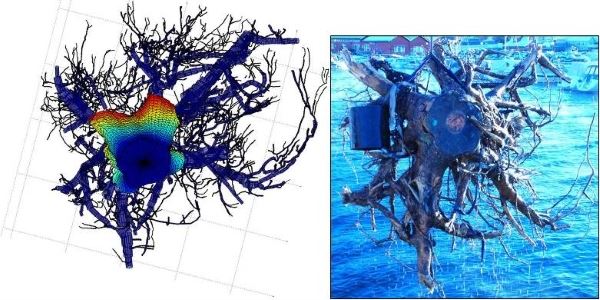
|
|
Figure 2: Root system images |
The root systems were suspended, scanned from three different angles, and the root surfaces from the co-registered point clouds were modelled with the 3D Quantitative Structure Model to determine root architecture and volume (see Figure 2). The modelling procedure facilitated the rapid derivation of root volume, diameters, break point diameters, linear root length, cumulative percentages, and root fraction counts. The modelled root systems underestimated root system volume by 4.4%.
In another paper, Smith developed belowground birch biomass functions. Obtaining accurate estimates of national belowground and whole tree biomass is important to better understand the global carbon cycle and to quantify biomass stocks and changes. Allometric birch biomass functions were derived from 67 trees for belowground and whole tree biomass using diameter at breast height and height as the independent variables. Comparisons with existing belowground birch biomass functions from Fennoscandia indicated considerable differences in estimates between existing functions. The derived data set for belowground birch biomass is the largest in Fennoscandia and the developed functions are likely the best available for estimating national birch biomass stock and stock change in Norway.
Bio-economic optimisation
Forest management is a complex task where conflicting interests often need to be handled. The development of methods and tools that may support forest managers in their decision-making is therefore important. Paulo Borges has dealt with different aspects of forest management over the past year. For certain forest areas in Norway law regulations do not allow large clear cuttings. One of Borges' studies therefore focused on solving methods related to maximum opening areas in harvest operations. The main objective was to develop methods minimising profitability losses because of such restrictions. In another paper, the nature areas surrounding Oslo (Oslomarka), which are the recreational home turf for a population of 1.2 mill. people, were used as case study area. Oslo municipality face multiple challenges in their management. Borges studied the effects of different environmentally oriented restrictions on available timber and biomass quantities from the municipality forest. Results showed that the profitability might be reduced by up 20% because of the restrictions. Still, however, a supply of 20-30 GWh annual energy from harvest residues can be provided from the municipality forest.
A third study by Borges focused on cost-efficient harvest operations. In strategic forest level planning, the harvest levels are typically obtained by maximising net present value (NPV) of the forest area. The resulting harvests are then also typically scattered over the area. The fixed costs, however, i.e. costs related to transferring the machines to the harvest site, waiting time for the machinery and workers due to the transfer, delineation of the harvest sites and administrative work required for each harvest site, will in such cases be high. In this study, clustering of harvest sites was carried out by minimising the total fixed costs for all harvest sites. The results showed, as expected, that when the fixed cost increased it was optimal to make larger and larger harvest clusters. At the same time, however, the clustering also affects the treatments to be carried out by making it profitable, for example, to harvest at lower or higher ages than the optimal rotation age settled when fixed costs is not considered.
WP1.2 - Logistics
The work in WP1.2 in 2015 has concentrated on temporary chipping terminals at roadside landings. The low bulk density of low-grade biomass assortments such as logging residues and whole trees limits the feasibility of transporting the material unprocessed. Chipping at forest roadside landing and consecutive woodchip transport is therefore a common step in this supply chain. The chip supply system deviates from the conventional roundwood supply in several aspects, and the interaction between equipment and work methods and the roadside landing should therefore be of interest. Forest roads are designed having the characteristics of the roundwood supply chain in mind. A good understanding of the physical requirements for a temporary roadside chipping terminal, and how these requirements are related to different equipment and work methods, is necessary both at tactical and operational planning, and supply chain configuration. To illuminate this issue a survey among practitioners in Norway were done to answer the following questions:
- What equipment and work methods are more or less common for chipping at temporary forest landings / terminals in Norway, and how optimal are these operational configurations?
- What are their requirements and wishes for the physical layout of a temporary roadside terminal?
- How is the utilization of the different supply chain elements affected by the terminals?
Fourteen sites were visited in the survey. The supply configurations studied here were "hot" systems, where the processing and transport units are closely dependent of each other. In such set ups the capacity ratio between the chipping and transport govern the achievable utilization for both units involved. In most cases the capacity of the transport unit(s) were lower than the chipper, but still the utilization of the transport units varied between 60 and 90 %.
In Figure 1, Plot 1 shows the chip transport productivity versus modelled productivity. The straight line is indicating where the achieved productivity would equal the capacity. Plot 2 and 3 shows the utilization of the transport capacity versus the capacity ratio between the chip transport unit(s) and the chipper (2) and versus the terminal functionality (3). The solid line in plot 2 indicate the maximum achievable utilization according to the capacity ratio between transport and chipping.
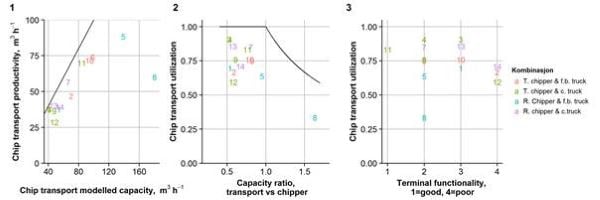
|
|
Figure 1: Results from study of chipping logistics: 1) chip transport productivity, 2) and 3) utilisation of the transport capacity. |
In Figure 2, the first plot (1) shows the total time consumption of the chipper per unit bulk volume versus estimated chipping capacity. The solid line illustrates the time consumption equivalent for the capacity, i.e. the time consumption if the chipper achieved maximum utilization. Plot 2 shows the chipper utilization versus the capacity ratio between the transport unit(s) and the chipper. Here the solid line shows the maximum chipper utilization that would be achievable for each capacity ratio. Plot 3 shows the chipper utilization versus the terminal functionality score.
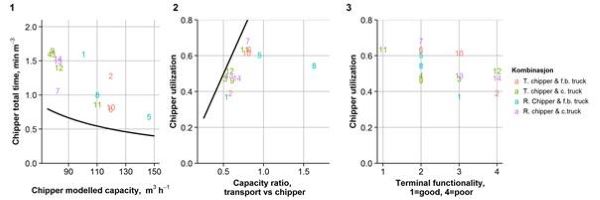
|
|
Figure 2: Utilization of chipper: 1) time consumption, 2) and 3) chipper utilization. |
WP1.3 - Biomass and residue characteristics and quality
Considerable variations of qualitative properties between stem wood, stem bark and branch wood of Scots pine forest residues vertically along the stem very observed. In average, the highest basic density showed to have branch wood, lower stem bark and the lowest one stem wood. The basic density of stem wood was higher in the lower part of stem, vertically decreasing to approximately towards to tree top (Table 1). Contrary, the basic density of stem bark decreased to 40 % height and then slightly increasing again towards the top. Branch wood had a higher basic density than stem wood. The basic density of branch wood decreased in the direction from the branch basis to its top. There was not found relationship between basic density of stem wood, stem bark and branches and the site index quality of selected forest stands.

|
|
Table 1: Average values of basic density (kg/m3) and standard deviations of Scots pine stem wood and stem bark along the tree trunk towards the top. |
Bark proportion and bark thickens were highly linear to the tree height (Figure 1). Bark proportion and thickness may be relevant aspects for the utilization of biomass feedstock from Scots pine forest raw material.
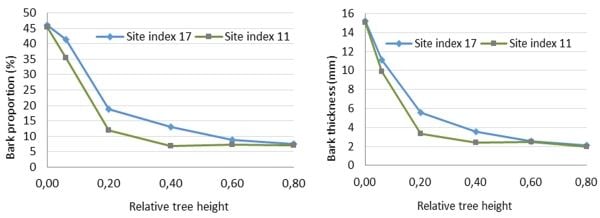
|
|
Figure 1: Trend in mean values of bark proportion (left) and bark thickness(right) of Scots pine. Site index = productivity class (how fast the forest grows). |
The chemical compositions and fusion behaviours of ashes from stem wood, bark, base branch and top branch were characterised with ICP-OES, STA and SEM-EDX. Compared to other three ashes, top branch ash contains considerably high content of K and P, and is rich in Ca and Si as well (Figure 2). STA analyses on four kinds of fuels indicate that melting of them might start in the temperatures range from 930 °C to 960 °C. In comparison to ash originated from stem wood, SEM-EDX analyses confirm that the ashes from stem bark, base branch and top branch have high sintering tendency. Top branch ash contains substantially high concentration of K and P elements. These two typical mobile elements in plants are often found in twigs containing a large amount of young and biologically active tissues. Abundance of K and P, together with Ca, may cause formation of low temperature melting K-Ca-phosphates, partially explaining high sintering tendency of the top branch ash.
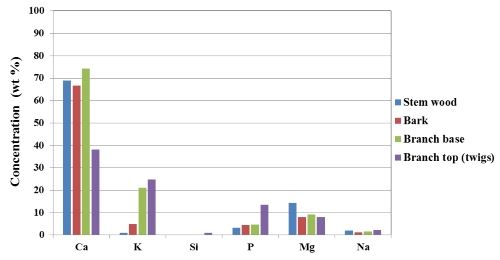
|
|
Figure 2: Average elemental composition in the formed ashes (presented on a carbon- and oxygen-free basis. Forest biomass moisture measurements in frozen conditions. |
Forest biomass supply to heating plants is subject to diverse constraints in the supply chain, from harvest to transport logistics, and not to forget all the challenges related to storage and preserving or increasing biomass quality before it is used for bioenergy. Winter biomass recovery operations provide for most of the yearly supply needs of heating plants in Scandinavia and frozen biomass is a very common feedstock delivered.
Moisture content (M) is one of the most important quality parameters of forest biomass used for bioenergy. M strongly influences the net calorific value of the delivered biomass and consequently the price per ton. The standard method currently used for determining M involves oven drying at 105 °C until stable weight is reached (oven-drying method). For buyers of biomass, a disadvantage of the oven-drying method is that it takes at least 24 hours before the M of the delivered biomass is determined. Many heating plants have limited storage space, so it is very likely that sampled biomass loads are fed to the boiler within this 24-hour period. Consequently, the advantages to the boiler operator of knowing the moisture content of the fuel fed to the boiler are lost, and the result is an increased risk of inefficient combustion.
Nordic forestry research institutes of Sweden (Skogforsk), Norway (NIBIO) and Canada (FPInnovations) joined forces in a collaborative study aiming to test whether the NIR Prediktor Spektron Biomass moisture meter has the necessary measurement precision and accuracy for determining M in forest biomass trading with emphasis on frozen material.
WP1.4 - Residue upgrading and use
As in previous years, the main activities in WP 1.4 are related to the Ph.D. work of Eva Brod «The recycling potential of phosphorus in secondary resources». In 2015 ash and anaerobic digestates from CenBio industry partners have been studied in a broader context to evaluate the recycling potential of phosphorus in secondary resources both from land based and marine based sectors in Norway.
Combining material flow analysis (MFA) and studies on phosphorus plant availability
In traditional material flow analysis (MFA) the total amount of phosphorus in secondary resources is estimated, and the recycling potential is evaluated according to the total P-amount. However, the fertilisation effect of P in secondary resources is often much lower than that of water-soluble mineral P fertiliser. This was confirmed in a study that was partly funded by CenBio, in which the plant available fraction of P in different secondary resources was determined by a bioassay [i],[ii]. Therefore, in cooperation with a research group of the industrial ecology programme at NTNU, led by prof. Daniel Müller, we developed a method to combine MFA and plant-availability of P from in different secondary P resources. The paper has been submitted to the journal Environmental Science & Technology. Our study showed that there is a large potential for increased P recycling of secondary P resources in Norway, and a potential for drastic reduction in use of mineral P as fertilizer, also when considering plant-availability of P in secondary resources. Although anaerobic digestates and ash has relatively high P use efficiency (PUE),7 animal manure and fish sludge from aquaculture represent the largest volumes of secondary P resources suitable for fertilizer use.9
International cooperation: research stay at ETH in Zürich
In the period August 2014-January 2015 Eva Brod had a 6-month stay at ETH in Zürich, Switzerland, and carried out an experiment using 33P radioisotope methods. The results from this experiment confirmed previous papers on P availability of secondary P materials,7,8 and a paper has been submitted to the special issue "Sustainable Phosphorus" in the journal Frontiers in Nutrition and Environmental Sustainability.
Ph.D. thesis
Eva Brod has now submitted her thesis «Recycling potential of secondary phosphorus resources» for evaluation. One of the main outcomes of the study is a system for predicting the P fertilisation effect of secondary P resources based on chemical analyses. It has been shown that the Norwegian traditional method for characterising P availability of secondary resources (AL-method) did not have any correlation with plant uptake. Therefore, other methods have been recommended for predicting P availability8that are presented in a decision tool: If P in the secondary resource in question has been precipitated with Al and/or Fe, Brod recommends predicting the P fertilisation effect based on the total concentration of Al and Fe in the product. This result is based on studies of Øgaard and Brod that have partly been funded by CenBio. Otherwise, P in the secondary resource is mainly present as calcium phosphates of different solubility. The solubility of calcium phosphates is dependent on pH of the target soil. Therefore, one of two extraction methods was recommended, depending on the pH in the target soil. If soil pH <6.5, Brod recommends extraction of P with water. If soil pH >6.5, we recommend predicting the fertilisation effect by the Olsen P method.
